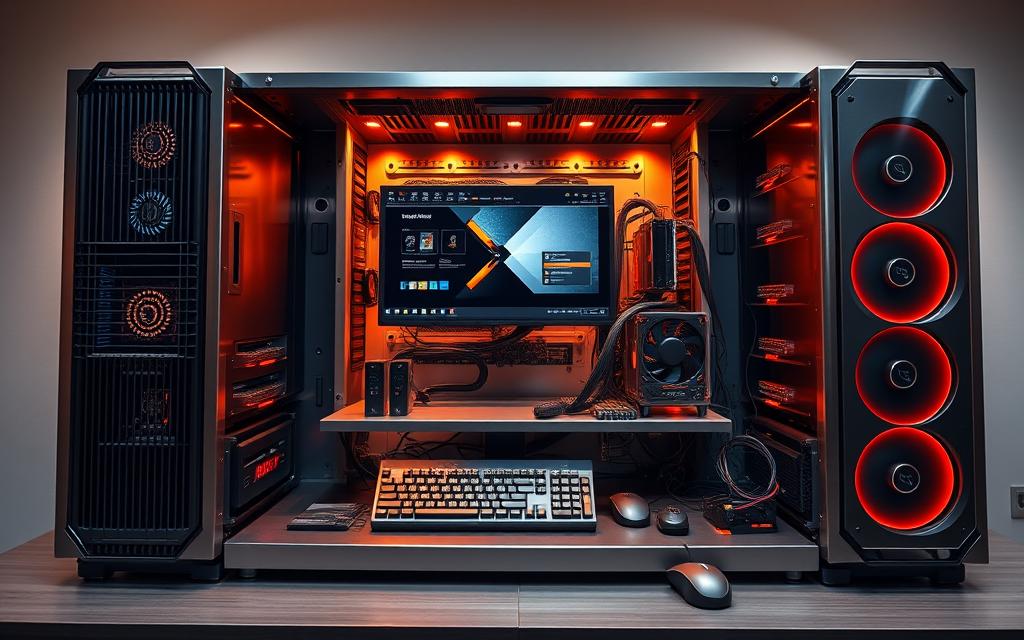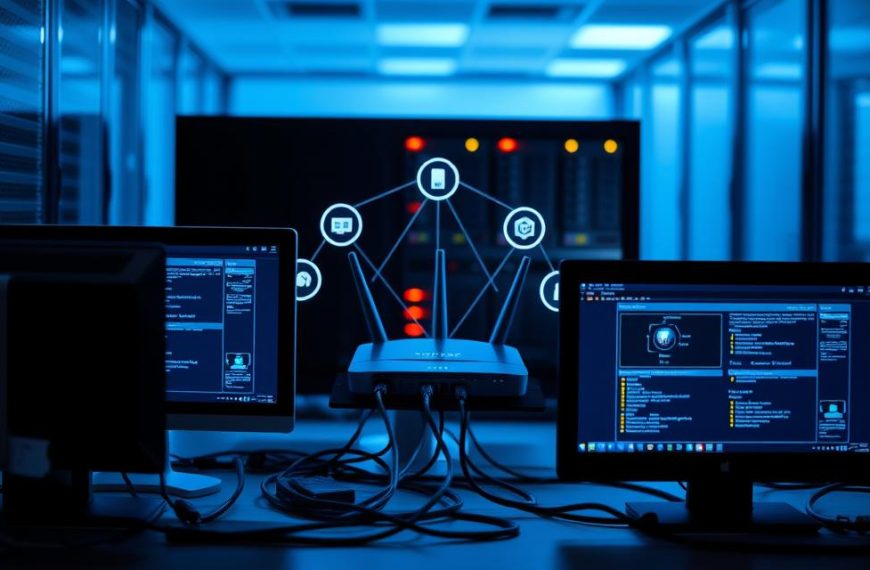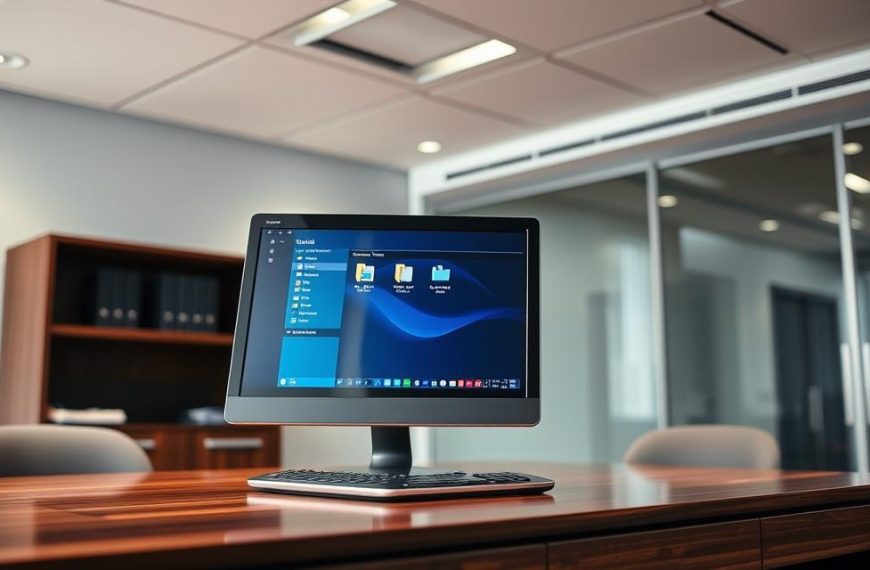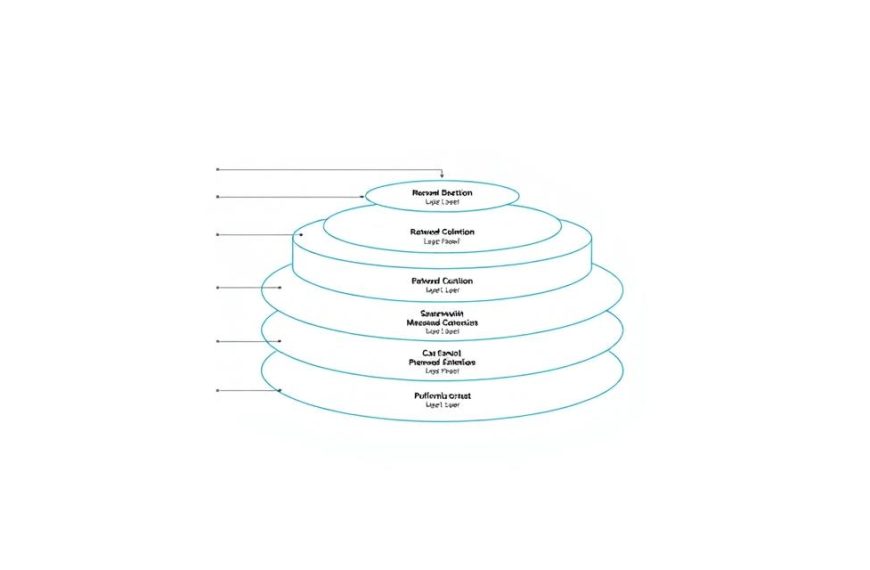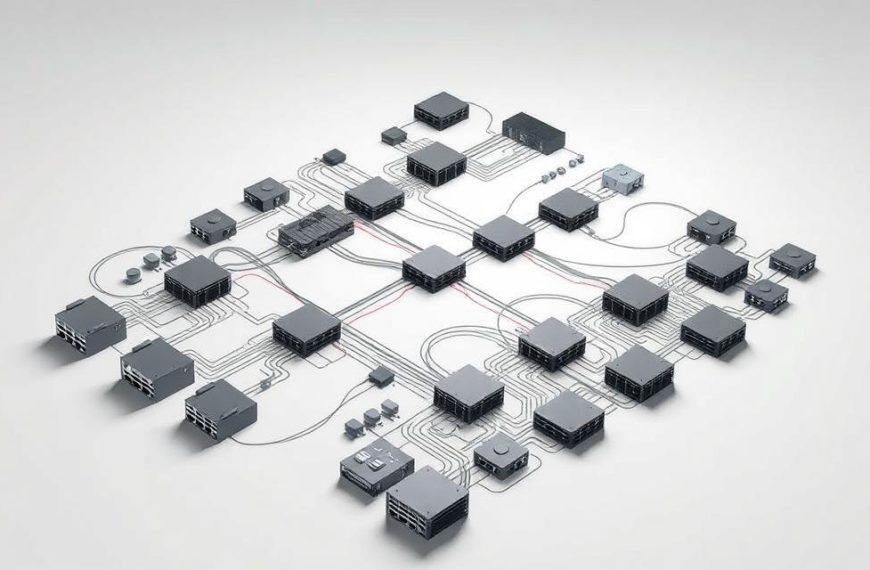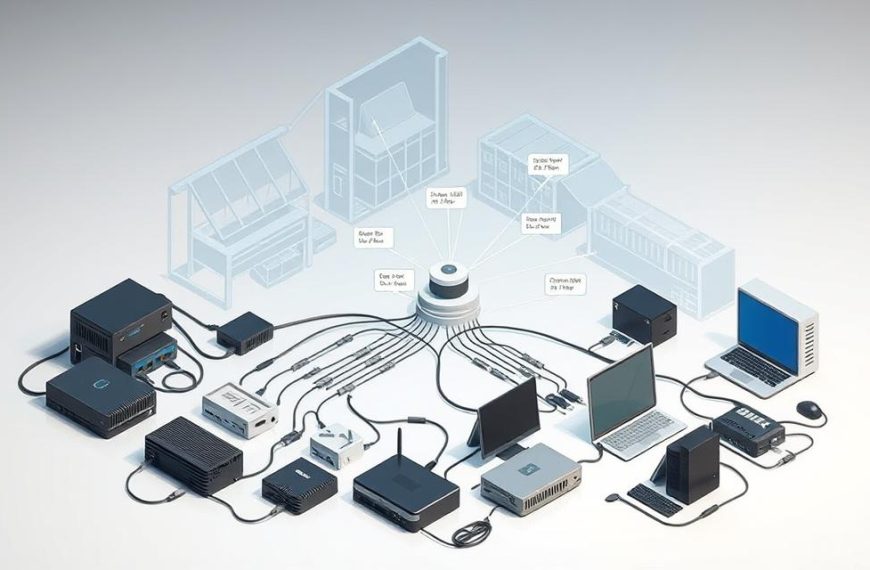In today’s world, a high-performance computer has special roles. It goes beyond what regular computers do. These machines are top-notch for one person’s work, especially for hard tasks.
This professional desktop is not like your average office computer. It’s made for tough jobs in tech and science. People like architects, engineers, and creators use it for its strong power.
A key feature of a networked computer workstation is its link to a local area network. This lets users share data and access resources easily. Yet, it still works fast for each person.
These machines stand out because they can process things quickly, have better graphics, and more memory. They are the best choice for those who need top-notch computing.
Defining the Network Workstation Concept
Network workstations are special computers for professional use. They are more powerful than regular computers. These machines are key for complex tasks in many fields, offering top performance.
Core Characteristics of Workstation Computers
Workstation computers have unique features. They include:
- High-performance multi-core processors
- Advanced error-correcting memory systems
- Professional-grade graphics capabilities
- Robust storage solutions with redundancy
- Enterprise-level operating systems
They focus on being stable and reliable. Workstations often use Unix systems or Linux for professional tasks.
“Workstations are optimised for the visualisation and manipulation of different types of complex data such as 3D mechanical design, engineering simulations…”
Historical Evolution of Workstation Technology
The idea of workstations started in the 1960s and 1970s. Early systems like the IBM 1620 were the first dedicated computers.
In the 1980s, Sun Microsystems and Silicon Graphics introduced 32-bit RISC systems. These systems improved graphics and processing for professionals.
Today, workstations use the latest technology. They still focus on reliability and performance for scientific computing and other tough tasks.
Distinguishing Features from Ordinary Computers
Workstations are different from regular computers in many ways. Here are some key differences:
| Feature | Workstation | Ordinary Computer |
|---|---|---|
| Processor Architecture | Multi-core Xeon or EPYC | Consumer-grade Core or Ryzen |
| Memory Technology | ECC RAM with error correction | Standard non-ECC memory |
| Graphics Capability | Professional GPUs (NVIDIA Quadro, AMD Radeon Pro) | Consumer gaming graphics |
| Reliability Testing | 24/7 operation certified | Standard usage patterns |
| Software Optimisation | Professional application certification | General consumer software |
These differences help workstations perform well under heavy loads. They are crucial for technical applications where failure is not an option.
Workstations are made for professional use. They focus on stability and performance, not on being user-friendly.
What is a Workstation in Computer Network: Technical Specifications
Workstations show their strength in their advanced hardware. They have parts made for serious work, not just everyday use.
Workstations use top-notch tech for steady and strong performance. Let’s look at the key parts that make these computers special.
Processor Architectures and Multi-core Configurations
Workstations use strong processors for tough tasks. The Intel Xeon processor is top for serious jobs, with great reliability and features.
For those needing lots of processing power, AMD’s Threadripper CPU is a great choice. It has lots of cores and is good for tasks like 3D rendering.
Many workstations can use two processors at once. This means they can handle even more tasks than usual.
Advanced Memory Systems and ECC Technology
Memory is a big difference between workstations and regular computers. Workstations have lots of RAM, from 64GB to many terabytes.
ECC RAM (Error-Correcting Code memory) is key for workstations. It checks and fixes memory errors, keeping data safe during long tasks.
For those working with big data or complex simulations, ECC RAM is a must. It gives peace of mind and is worth the extra cost.
Professional Graphics Cards and Display Solutions
Graphics processing is a big difference between workstations and regular computers. Workstations need professional GPU solutions for stability and precision, not just for gaming.
These graphics cards are tested and certified for professional software. They have drivers that are best for CAD, rendering, and scientific visualisation.
NVIDIA Quadro Series Graphics Processors
NVIDIA’s Quadro series is the top for workstation visualisation. They offer great performance in professional apps.
Quadro cards have drivers certified for major CAD and content creation apps. They ensure stability and compatibility, unlike gaming cards.
AMD Radeon Pro Graphics Solutions
AMD’s Radeon Pro cards are a good choice for workstations. They offer great performance in OpenCL-accelerated apps and are priced well.
These cards have advanced features like ProRender and optimised drivers for professional software. They offer great value for certain workflows.
Both NVIDIA and AMD professional graphics support multiple high-resolution displays. This is important for complex multi-monitor setups needed for professional work.
Workstation versus Desktop Computer: Comprehensive Comparison
Choosing between workstations and desktop computers is a big decision for professionals. It affects how well they work, how reliable the systems are, and the cost over time. Even though modern desktops are getting better, workstations still have key advantages for certain tasks.
The main differences are not just about how fast they are. It’s also about how they’re built, tested, and how well they work. This comparison looks at both types from different angles to help users make the right choice.
Performance Benchmarks and Reliability Metrics
When it comes to heavy tasks, workstations outperform desktops. They are better at tasks like 3D rendering, complex simulations, and handling large amounts of data.
For example, a top workstation can do 3D rendering tasks 40-60% faster than a gaming desktop of the same price. This is because workstations have special hardware and components made for constant use.
Workstations also have ECC memory. This memory checks and fixes data errors, preventing crashes during important work.
They have better cooling systems and tested parts for stable performance over long periods. This is very important in work settings where a system crash can really slow things down.
Specific Use Case Scenarios for Each System Type
Desktop computers are great for everyday tasks. They’re perfect for office work, browsing the web, and fun activities.
Gaming desktops are also good for fun. They focus on graphics and are more affordable than workstations.
Workstations are for specific jobs in many fields:
- Engineering design and CAD applications
- Scientific research and data visualisation
- Professional media creation and 3D rendering
- Financial modelling and quantitative analysis
Workstations are made to work well with professional software. This makes them worth the extra cost for certain users.
Total Cost of Ownership Considerations
The cost of a workstation is not just the price you pay upfront. They cost more at first but last longer and work better over time.
Workstations mean less downtime and more work done. They last 2-3 years longer than desktops, saving money in the long run.
Workstations also cost less to maintain. They’re tested more, which means they break down less and cost less to fix.
| Cost Factor | Standard Desktop | Workstation |
|---|---|---|
| Initial Investment | $800 – $2,000 | $2,500 – $6,000+ |
| Expected Lifespan | 3-4 years | 5-7 years |
| Annual Maintenance | $150 – $300 | $75 – $150 |
| Productivity Impact | Moderate | High |
| Resale Value (%) | 25-35% | 40-50% |
Looking at the total cost, workstations are a better deal for professional use. They’re more reliable and perform better, making them a good investment for those who need top-notch computing.
Before choosing between a workstation and a desktop, businesses should think about what they need. The right choice depends on the tasks and how the system will be used.
Primary Applications and Industry Utilisation
Many industries use workstations to solve tough problems and make complex digital content. These systems are great in places where normal computers can’t handle the job. They deal with special software and big data.
Engineering Applications: CAD and CAM Software
Engineering and architecture firms need workstations for design and manufacturing. These systems handle 3D modelling, simulation, and analysis that normal computers can’t do.
Workstations offer the precision and stability needed for:
- Mechanical design and engineering simulations
- Computational fluid dynamics analysis
- Architectural modelling and structural analysis
- Manufacturing process planning and optimisation
Their strong processing power makes CAD/CAM software run smoothly. This lets professionals work with detailed designs without any slowdowns.
Scientific Research: Data Analysis and Visualisation
Research places use workstations for big data and detailed visualisations. These systems speed up research by doing complex tasks well.
Key uses include:
- Genomic sequencing and biological research
- Climate modelling and environmental analysis
- Medical imaging and diagnostic processing
- Astronomical data processing and simulation
Workstations help researchers do complex calculations. They also create data visualisation that helps in scientific discovery and analysis.
Media Production: Video Editing and 3D Rendering
The media and entertainment world relies on workstations for making content. These systems have the graphics power needed for high-quality video and complex 3D animations.
Professional workstations are good at:
- 4K and 8K video editing and colour grading
- 3D animation and character modelling
- Visual effects composition and rendering
- Virtual reality content development
Their advanced graphics ensure smooth playback and fast 3D rendering. This makes production workflows better and helps meet deadlines.
Financial Modelling and Quantitative Analysis
Financial firms use workstations for complex modelling and risk analysis. The accuracy and speed are key for making smart financial choices.
These systems handle tough tasks like:
- Risk assessment and portfolio analysis
- Algorithmic trading system development
- Large database processing and SQL queries
- Market trend analysis and forecasting
Workstations are reliable for financial analysis and quantitative modelling. They are crucial because small errors could have big financial impacts.
Selecting the Optimal Workstation Configuration
Choosing the right workstation is all about knowing what you need and how much you can spend. The market is filled with big names like Dell, HP, and Lenovo, each offering strong options.
“by the early 2000s, this difference largely disappeared, since workstations use highly commoditized hardware dominated by large PC vendors, such as Dell, HP Inc., and Fujitsu…”
It’s important to know what each brand offers. We’ll look at the top choices and what to consider when building your own.
Dell Precision Series Workstation Models
The Dell Precision series is known for its reliability and wide range of options. It meets the needs of professionals in many fields.
Dell has both tower and mobile workstations. Their customisation options are great for both companies and individual users.
They offer excellent warranty support and stable performance. The Dell Precision line is praised for its build quality and cooling.
HP Z Series Workstation Offerings
HP’s Z series is another top choice for workstations. These systems are known for their ability to grow and perform at the highest levels.
The Z series comes in tower and desktop forms. HP uses innovative cooling and easy upgrade features.
They also have unique tech like HP’s Z Turbo Drive. The HP Z series is perfect for those who need to expand and stay ahead.
Lenovo ThinkStation Product Line
Lenovo’s ThinkStation series offers strong performance and quality. These workstations are built for the toughest professional tasks.
The ThinkStation line gives great value and reliability. Lenovo focuses on design, like noise reduction.
They ensure top performance with major software through ISV certification. This means your system works well with key applications.
Custom-built Workstation Considerations
For special needs, a custom workstation might be the best choice. You get to pick every part.
Building a custom system means planning carefully. You need to choose the right CPU, GPU, memory, storage, and cooling.
The main plus of a custom build is it’s made just for you. But, it needs technical know-how and you lose manufacturer support.
| Configuration Aspect | Pre-built Workstation | Custom Build |
|---|---|---|
| Warranty Coverage | Comprehensive manufacturer support | Individual component warranties |
| Performance Optimisation | General professional use | Application-specific tuning |
| Initial Cost | Higher upfront investment | Potential cost savings |
| Upgrade Flexibility | Manufacturer-dependent | Complete component freedom |
| Technical Support | Single-point responsibility | Self-managed troubleshooting |
Your choice should match your performance needs and support needs. Both pre-built and custom workstations have their own benefits.
Conclusion
Workstations are a top-notch computing solution for tough professional settings. They handle complex tasks better than regular PCs, offering unmatched reliability and performance.
These systems are perfect for engineering, scientific research, and media production. They have validated components for stable, critical applications.
Since the late 1990s, the difference between workstations and consumer PCs has faded. Modern workstations use AMD or NVIDIA GPUs for top-notch computing. But, their special design is key for serious projects.
Workstations are great for both solo developers and big companies. They let users explore new limits in data analysis, 3D rendering, and more.
The future of workstations is exciting. They will keep getting better, adding new tech to meet growing needs. This keeps them important in our fast-changing digital world.
Choosing a workstation is a smart move for better productivity and precision. It’s a wise choice for those dealing with heavy workloads.
